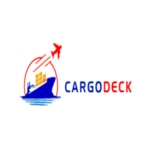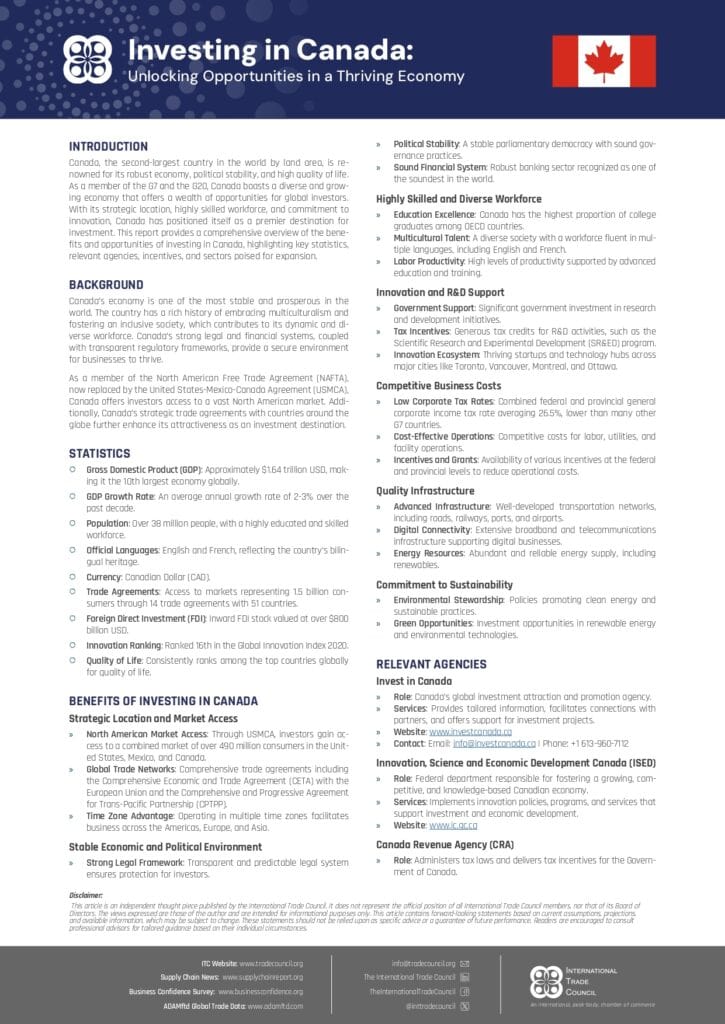-
- Type of Government: Federal Parliamentary Democracy and Constitutional Monarchy
- Population: Approximately 38 million
- GDP: Around $2 trillion USD
- Corporate Tax Rate: 15% (federal rate)
- Personal Income Tax Rate: Progressive, up to 33% (federal rate)
- Major Exports: Crude oil, automobiles, machinery
- Major Imports: Machinery, vehicles, electronics
Doing Business with Canada
A comprehensive guide to doing business, exporting, investing, and manufacturing in Canada.
Exporting to Canada involves several steps to ensure compliance with local regulations. Here’s a detailed guide:
-
Conduct Market Research
- Analyze demand for your product in Canada.
- Identify potential competitors and market entry strategies.
-
Verify Product Compliance
- Ensure your product meets Canadian standards and regulations.
- Contact the Canada Border Services Agency (CBSA) for guidance.
-
Understand Tariffs and Taxes
- Check applicable import duties and taxes for your goods.
-
Arrange Logistics and Shipping
- Choose a reliable shipping company familiar with Canadian logistics.
- Ensure all shipping documents are accurately completed.
-
Prepare Documentation
- Include commercial invoices, packing lists, and certificates of origin.
- Verify compliance with Canadian customs requirements.
-
Customs Clearance
- Work with a customs broker to facilitate the clearance process.
- Pay any duties and taxes required for the import.
-
Distribution and Sales
- Establish distribution channels within Canada.
- Consider partnerships with local businesses for effective market penetration.
Key Contacts
- Canada Border Services Agency (CBSA)
- Website: cbsa-asfc.gc.ca
Importing goods into Canada involves several steps to ensure compliance with local regulations. Here’s a detailed guide:
-
Register Your Business
- Ensure your business is registered in Canada.
- Obtain a Business Number (BN) from the Canada Revenue Agency (CRA).
-
Classify Your Goods
- Use the Harmonized System (HS) codes to classify your goods accurately.
-
Verify Import Regulations
- Familiarize yourself with Canada’s import regulations.
- Check if your goods require special permits or certificates.
-
Check Tariffs and Taxes
- Identify applicable import duties and taxes for your goods.
-
Arrange Logistics and Shipping
- Select a reputable shipping company.
- Ensure all shipping documents are accurately completed.
-
Prepare Import Documentation
- Include commercial invoices, packing lists, and certificates of origin.
- Ensure compliance with Canadian customs requirements.
-
Customs Clearance
- Work with a customs broker to facilitate the clearance process.
- Pay any duties and taxes required for the import.
-
Receive and Distribute Goods
- Arrange for the delivery and distribution of goods upon clearance.
- Set up local partnerships if needed.
Key Contacts
- Canada Border Services Agency (CBSA)
- Website: cbsa-asfc.gc.ca
- Canada Revenue Agency (CRA)
- Website: cra-arc.gc.ca
Incorporating a company in Canada involves several key steps. Here’s a detailed guide:
-
Choose a Business Structure
- Decide on the type of company, such as a corporation or limited liability partnership.
-
Select a Business Name
- Ensure your desired company name is unique and complies with naming regulations.
- Conduct a NUANS (Newly Upgraded Automated Name Search) report to check name availability.
-
Prepare Incorporation Documents
- Draft the Articles of Incorporation.
- Include details of directors, shareholders, and company address.
-
Register the Business
- File incorporation documents with the federal or provincial government.
- Choose between federal incorporation (Canada Business Corporations Act) or provincial incorporation.
-
Obtain a Business Number (BN)
- Register for a Business Number through the Canada Revenue Agency (CRA).
-
Register for GST/HST
- If applicable, register for the Goods and Services Tax/Harmonized Sales Tax.
-
Obtain Necessary Licenses and Permits
- Determine if specific licenses or permits are required based on your industry.
Costs
- NUANS Report: Approximately $13 CAD.
- Federal Incorporation Fee: $200 CAD (online).
- Provincial Incorporation Fees: Varies by province; check local regulations.
Key Contacts
- Corporations Canada
- Canada Revenue Agency (CRA)
- Website: cra-arc.gc.ca
Setting up a manufacturing plant in Canada involves several steps. Here’s a detailed guide:
-
Conduct Market Research
- Analyze local demand and industry trends.
- Evaluate potential competitors and supply chain logistics.
-
Choose a Suitable Location
- Identify industrial zones with necessary infrastructure.
- Contact local municipalities for available sites and incentives.
-
Register Your Business
- Incorporate your company through federal or provincial registration.
- Obtain a Business Number (BN) from the Canada Revenue Agency (CRA).
-
Obtain Necessary Permits
- Apply for construction, environmental, and zoning permits.
- Contact local government offices for specific requirements.
-
Secure Financing
- Explore funding options through banks or investment agencies.
- Consider government incentives for manufacturing.
-
Design and Construct the Facility
- Hire architects and contractors familiar with Canadian regulations.
- Ensure compliance with building codes and safety standards.
-
Install Equipment and Machinery
- Import necessary machinery, ensuring compliance with Canadian regulations.
- Coordinate with customs for smooth importation.
-
Recruit and Train Staff
- Hire local talent and provide necessary training.
- Contact local employment services for assistance.
-
Register for Taxation
- Ensure your business is registered for applicable taxes with the CRA.
-
Begin Operations
- Ensure all systems are in place and test the production line.
- Implement quality control measures.
Key Contacts
- Canada Revenue Agency (CRA)
- Website: cra-arc.gc.ca
- Corporations Canada
Registering a trademark in Canada involves several steps to ensure legal protection. Here’s a detailed guide:
-
Conduct a Trademark Search
- Use the Canadian Trademarks Database to check if your trademark is available.
-
Prepare Your Application
- Gather necessary information: trademark representation, goods/services classification, and applicant details.
-
Submit Your Application
- File the application online through the Canadian Intellectual Property Office (CIPO).
-
Pay the Application Fee
- The basic fee is $347.35 CAD for online applications.
-
Examination Process
- CIPO reviews the application for compliance and potential conflicts.
- Respond to any objections or requests for additional information.
-
Publication and Opposition
- If approved, the trademark is published in the Trademarks Journal.
- There is a two-month period for third parties to oppose the registration.
-
Registration and Certification
- If no oppositions arise, the trademark is registered.
- Receive a certificate of registration.
-
Maintain and Renew the Trademark
- Trademarks are valid for ten years and can be renewed indefinitely.
- Submit renewal applications before expiry to maintain protection.
Costs
- Application Fee: $347.35 CAD for online applications.
- Renewal Fee: $421.02 CAD.
Key Contacts
- Canadian Intellectual Property Office (CIPO)
Resolving commercial disputes in Canada involves several steps and options. Here’s a guide on the process:
-
Attempt Negotiation
- Start by negotiating directly with the other party to find an amicable solution.
-
Mediation
- Engage a neutral third-party mediator to facilitate discussions.
- Mediation services can be found through provincial legal aid offices.
-
Arbitration
- Consider arbitration as an alternative to court litigation.
- The ADR Institute of Canada can assist.
-
Seek Legal Advice
- Consult with a lawyer specializing in commercial law for guidance on your case.
-
File a Lawsuit
- If other methods fail, file a lawsuit in the appropriate court.
- Court fees vary; consult the specific court for details.
-
Court Proceedings
- Prepare for the legal process, which includes hearings and presenting evidence.
-
Judgment and Enforcement
- If a judgment is made, ensure its enforcement through legal channels.
Costs
- Mediation and Arbitration Fees: Vary depending on the service provider.
- Court Filing Fees: Dependent on the province and case type; consult local courts.
- Legal Fees: Vary based on the lawyer and complexity of the case.
Key Contacts
- ADR Institute of Canada
- Website: adric.ca
- Provincial Legal Aid Offices
- Contact local offices for mediation services.
When considering doing business in Canada, it’s important to understand various factors that can influence operations. Here’s an overview of social, cultural, political, and economic aspects:
Social and Cultural Factors
- Language and Communication
- Canada is bilingual, with English and French as official languages.
- Business communication is generally formal and respectful.
- Business Etiquette
- Punctuality and professionalism are highly valued.
- Building relationships and trust is important in business dealings.
Political Environment
- Government Structure
- Canada is a federal parliamentary democracy and constitutional monarchy.
- The political environment is stable and supportive of business.
- Regulatory Environment
- Well-established regulatory framework with clear business laws.
- Strong protection for intellectual property and contracts.
Economic and Foreign Exchange Factors
- Currency
- The currency is the Canadian dollar (CAD), which is freely traded on global markets.
- Exchange rates can fluctuate, impacting import/export costs.
- Investment Climate
- Canada offers a favorable investment climate with various incentives for foreign investors.
Rule of Law
- Legal System
- Based on English common law, except in Quebec, which follows civil law.
- Strong legal framework with independent judiciary and enforcement of laws.
- Property Rights
- Well-defined and protected by law, facilitating secure business operations.
Infrastructure
- Transportation and Logistics
- Advanced infrastructure, including extensive road, rail, and port networks.
- Reliable telecommunications and internet services.
Relevant URLs
- Canadian Trade Commissioner Service: tradecommissioner.gc.ca
- Canada Business Network: canadabusiness.ca
Ask our Experts on Doing Business in/with Canada
If you’re looking to do business or invest in Canada, we can provide expert guidance, market insights, and valuable connections to help you navigate the local landscape. Contact us today to discover how we can assist in making your venture a success.











































